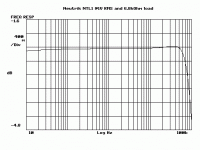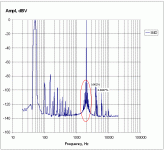john curl said:A bit expensive, but with such perfection in such a small package, why not?
Here is FR for 6K8 load, again without any additional RC (thought input of the analyser + cable add up to about 100pF, I think). Nice antialiasing for free 🙂 .
Alex
Attachments
Home, sweet home. Just like it was 40 years ago when I was designing Ampex tape recorder electronics, input and output transformers, both. You should also measure the more realistic tranformers, affordable to the Mackie, etc recordists. $64 is a lot of electronics, please remember, especially digital.
john curl said:$64 is a lot of electronics, please remember, especially digital.
Oh, yes. That is exactly what I am trying to avoid by using these cuties 🙂 . I'll have no active stages on the input of ADC, just a transformer directly into a SAR ADC (no delta-sigma either). Just a fun project, for my own pleasure (and, hopefully, some vinyl back-up 😉 )
Alex
Looks like EURO-->DOLLAR conversion losses.x-pro said:I've paid about $140 for a pair 🙁 . Planning to use these on the input of 24-bit ADC I'm building.

Around here they list for EUR40, which really is on the cheap end of of the scale, compared to most other pro xformer brands/models. At a UK dealer I saw them for a matching GBP30 (which would amount to $60).
- Klaus
I have purchased entire 24bit/96K systems for $140. Why would I want to add transformers and double the price? Is there any good reason?
More fun:
Here is IMD of some nickel core 600:600 line transformer from a respectful manufacturer.
Same two signals of 0dBV level - 50Hz and 2kHz.
Klaus, you can subtract portion of dry signal from your distorted one
Here is IMD of some nickel core 600:600 line transformer from a respectful manufacturer.
Same two signals of 0dBV level - 50Hz and 2kHz.
My little Xicon gets pretty hot after a while...
Klaus, you can subtract portion of dry signal from your distorted one
Attachments
john curl said:I have purchased entire 24bit/96K systems for $140. Why would I want to add transformers and double the price? Is there any good reason?
There is only one way to find out - try it, and that is what I am going to do 🙂 .
Alex
dimitri said:More fun:
Here is IMD of some nickel core 600:600 line transformer from a respectful manufacturer.
Same two signals of 0dBV level - 50Hz and 2kHz.
0dBV relative to what? 😀
Was that a "repeat coil" input transformer or an output transformer?
se
Was that a "repeat coil" input transformer or an output transformer?
It was line output transformer, 600 Ohm (150+150/600)Ohm, w/o faraday shield (I suspect)
Mr.Curl,
....................careful, you might become a transformer fan if you keep this up. For the most part this exchange has been most informative.
Jam
....................careful, you might become a transformer fan if you keep this up. For the most part this exchange has been most informative.
Jam
john curl said:dBV usually means relative to 1V.
Yes, John, I know. Did you miss the big smiley face after my question?
It was a little self-deprecating humor.
When dimitri posted the first IMD plot, he said "Two signals of of 0dB level..."
I asked him "0dB relative to what?"
He replied that it was dBV and reminded me that dBV was called out in the y axis of the plot, which I had embarrassingly overlooked.
So when he specifically said "0dBV" in his latest post, I replied "0dBV relative to what?"
In other words, I was poking a little fun at myself.
You should try it yourself sometime, John.
se
john curl said:I have purchased entire 24bit/96K systems for $140. Why would I want to add transformers and double the price? Is there any good reason?
Well, it depends. If cheap is good enough, fine, so maybe it's not for Parasound. But there are those of us who want the best performance we can get. And the measurable and sonic consequences of using a good input transformer are substantial. I came at it pretty skeptical myself, loaded down with memories of old Peerless and Ampex. But after I actually used some modern transformers in a design and heard the difference...
It only confuses everyone else, Steve. I have a good sense of humor, but I don't find your input very funny most of the time, in reference to me, or the subjects that I am interested in.
SY believes, everyone! I know that he has not 'proven' anything, but he believes that a 'good' transformer is an amazing adjunct to everyone's quality hi fi system. For some reason, what my associates and I have heard for the last 40 years doesn't count.
How about if we nominate the Neutrik NTL1 as a contender for a fairly reasonably priced, small, professional grade input transformer? If not Neutrik, then what about Jensen or Cinemag? More expensive probably, and larger, but maybe, just maybe, measuring slightly better.
Maybe we could get a group buy on the best of the contenders. Put me down for 2.
How about if we nominate the Neutrik NTL1 as a contender for a fairly reasonably priced, small, professional grade input transformer? If not Neutrik, then what about Jensen or Cinemag? More expensive probably, and larger, but maybe, just maybe, measuring slightly better.
Maybe we could get a group buy on the best of the contenders. Put me down for 2.
SY said:Well, it depends. If cheap is good enough, fine, so maybe it's not for Parasound. But there are those of us who want the best performance we can get. And the measurable and sonic consequences of using a good input transformer are substantial.
This is no place to be talking about sonics, SY.
Stick to the numbers, please.
se
john curl said:It only confuses everyone else, Steve.
No, John, it doesn't. Everyone else who sees a big green smiley face at the end of a question has a clue that the question wasn't quite intended to be a serious one.
se
x-pro said:
Here is FR for 6K8 load, again without any additional RC (thought input of the analyser + cable add up to about 100pF, I think). Nice antialiasing for free 🙂 .
Alex
Good job, Alex and others.
Yes, the transformer HF peaking and distortion is very dependent on matching the driving circuit to the transformer's characteristic input impedance. The secondary RC network is used to minimize the HF peaking with the input and output impedances *exactly* as specified. The HF response will also degrade as the output impedance is reduced. I tested the Jensen CL-22R ISO-MAX and the Lundahl LL-1592 for audioXpress magazine and observed these potential application problems.
I have worked with just about every magnetic material there is. I don't particularly care for metglas (I used to work for AlliedSignal, who developed the amorphous metals, now Honeywell. But they since sold the whole metglas line to Hitachi I think.). It has a very low curie point and the various square-loop alloys are more non-linear than the cold-rolled >50% nickel core materials (orthonol, permalloy, mu-metal, etc.) used in audio transformers. Mostly they are used for pulse transformers and switching power supply magnetics. There is a more linear metglas alloy (2714A) used for some instrument transformers, but it is cobalt-based. Not ideal for audio.
One material I especially liked for instrument transformers was SatMu Metal, about 65% Ni, 30% Fe, some Mb, Si. Telco in the UK developed it and it had the losses of orthonol with a high saturation almost equal to GOSS (3% grain-oriented silicon steel). The knee-point flux density was only 10% lower, and it has 1/3 the magnetizing current of GOSS. It was annealed in a magnetic field, which made it fairly expensive. Magnetics, Inc. licensed it in the USA and developed a line of cores (Code Y) in the same sizes as their other cores. Telco dropped it because of the expense and low demand, then Mag Inc. did the same. Like all nickel alloys, it was very sensitive to magnetostriction and didn't like to be potted. Aluminum core boxes filled with an inert silicone damping compound were mandatory. Even GOSS is somewhat magnetostrictive, so I always temperature cycle all of my designs to remove the stress caused by winding.
I'm not an audio transformer designer. No question, audio transformer design is a real art as well as a science.
Best, Chuck Hansen
- Status
- Not open for further replies.
- Home
- Amplifiers
- Solid State
- John Curl's Blowtorch preamplifier

